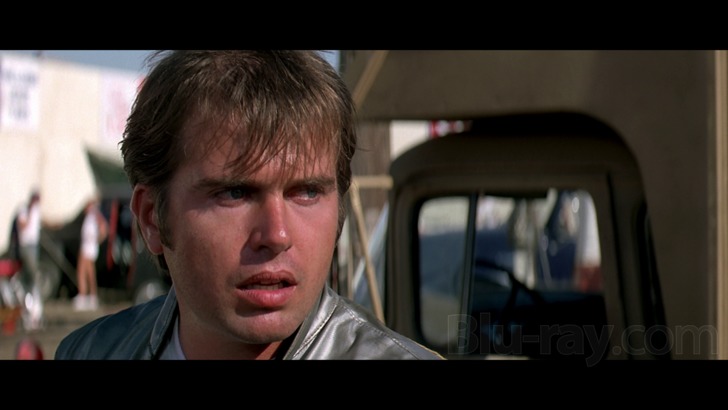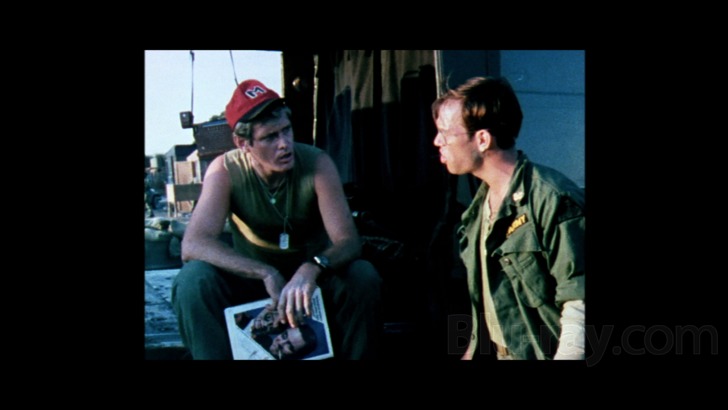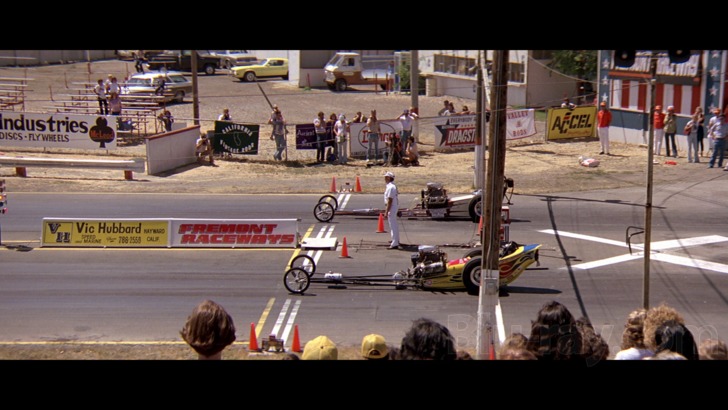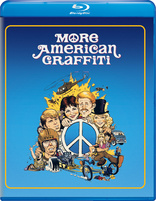More American Graffiti Blu-ray Movie
HomeMore American Graffiti Blu-ray Movie 
Universal Studios | 1979 | 111 min | Rated PG | Jun 12, 2018Movie rating
5.9 | / 10 |
Blu-ray rating
| Users | 4.5 | |
| Reviewer | 3.5 | |
| Overall | 3.5 |
Overview
More American Graffiti (1979)
College graduates deal with Vietnam and other issues of the late '60s.
Starring: Candy Clark, Bo Hopkins, Ron Howard, Paul Le Mat, Mackenzie PhillipsDirector: Bill Norton
| War | Uncertain |
| Comedy | Uncertain |
| Drama | Uncertain |
Specifications
Video
Video codec: MPEG-4 AVC
Video resolution: 1080p
Aspect ratio: 2.35:1
Original aspect ratio: 2.39:1
Audio
English: DTS-HD Master Audio 5.1 (48kHz, 24-bit)
Subtitles
English SDH
Discs
Blu-ray Disc
Single disc (1 BD)
Playback
Region A (B, C untested)
Review
Rating summary
| Movie | 4.0 | |
| Video | 3.0 | |
| Audio | 4.5 | |
| Extras | 0.0 | |
| Overall | 3.5 |
More American Graffiti Blu-ray Movie Review
Reviewed by Brian Orndorf July 3, 20181973’s “American Graffiti” is a masterpiece. While writer/director George Lucas would go on to become a filmmaking legend with “Star Wars,” his second film is just as enchanting, detailing a special night, the last of adolescence for a group of teenagers, in 1962. It’s an evocative, charming, painfully relatable endeavor that showcased Lucas’s skills with performance and atmosphere, pouring his heart into a semi-autobiographical picture that was boosted by a killer soundtrack and gauzy, engaging cinematography. “American Graffiti” ended with a sobering epilogue revealing the fates of the participants, but the movie was a smash hit, and with “Star Wars” securing its position as one of the most famous features of all time, Lucas elected to return to the creamy nostalgia of his earlier success, concocting “More American Graffiti” in 1979 with writer/director Bill L. Norton, looking to create the next logical step for characters experiencing the pure potential of tomorrow in the comfort of their hometown: complete disillusionment.

It’s New Year’s Eve in 1964, and John Milner (Paul LeMat) is looking to become a major force on the drag racing circuit, only to find interest from a major sponsor cripplingly conditional, forcing him to figure out victory on his own, proving himself. Joining him is Eva (Anna Bjorn), an Icelandic woman he’s attracted to, juggling the needs of competition with the desires of his heart. In 1965, Terry “The Toad” Fields (Charles Martin Smith) is trapped in Vietnam, struggling to find a return ticket back home, planning self-harm to trigger his release. Facing the wrath of Major Creech (Richard Bradford), Toad fakes enthusiasm for service, searching for any opportunity to escape the war. In 1966, Debbie Dunham (Candy Clark) is a hippie in San Francisco pledging her love to Lance (John Lansing), who doesn’t return the passion. Wandering through the counterculture movement of the era, Debbie ends up joining the band Electric Haze, bonding with guitarist Newt (Scott Glenn). And in 1967, Laurie (Cindy Williams) and Steve Bolander (Ron Howard) are locked in combat, with the mother-of-two unable to join the workforce, pinned down to domestic duties by her husband. Finding temporary shelter with brother Andy (Will Seltzer), Laurie is introduced to the protest movement, caught up in draft card burnings and riots.
“American Graffiti” examined life on the edge of adulthood, following teenagers and adolescents at heart on one last ride together around the cruising scene in Modesto, California, taking stock of their fears about the future as they negotiated a transition that wasn’t entirely welcome to some. “More American Graffiti” showcases the sobering reality of maturity, or at least some sense of it, which gives the endeavor a more solemn atmosphere. Part of the gloom is brought on by awareness of character fates, with Lucas concluding the original picture with the reveal that John actually died in 1964, while Toad went MIA in Vietnam, leaving the audience with a gut-punch of reality after soaking in the juices of mischief for two hours. “More American Graffiti” has the challenge of answering questions nobody is asking, but Norton is up for the job, following Lucas’s orders to break up the story into four timelines, tracking volatile New Year’s Eve celebrations for most of the “Graffiti” crew (Richard Dreyfuss is noticeably missing from the line-up).
Visually, “More American Graffiti” is ambitious, identifying the changing times by fiddling with aspect ratios, remaining tightest on Toad’s claustrophobic experience in Vietnam, where the once proud military man’s enthusiasm for combat has been erased by American hubris, watching men in charge throw away human lives to keep up the appearance of success. The widest frame remains with John, who’s enduring an anxious day of racing, trying to prove himself to those who are ready to bully and dismiss him, finding a distraction in an Icelandic woman who doesn’t speak English. Working overtime to sell the counterculture uprising is Debbie’s adventure, which employs lively split-screen work to generate a proper acid freak-out, replicating filmmaking interests of the era. Even if “More American Graffiti” doesn’t connect dramatically, its presentation is unique, going the extra mile to separate the subplots while still connecting them through references to the dead and the disappointed, while cameos help to secure the “Graffiti” mood are present, including Harrison Ford, Mackenzie Phillips, and Bo Hopkins, reprising his role as gang leader Little Joe, who’s now pals with Toad, with the men trying to make sense of duty that’s basically sending them to their deaths.
More American Graffiti Blu-ray Movie, Video Quality 

As previously mentioned, "More American Graffiti" is a visually ambitious film, and the AVC encoded image presentation respects the various aspect ratios in play, with the 2.35:1 frame being the dominant visual width before various time periods play with size. It's an older master from Universal, with filtering flattening the viewing experience, smoothing detail from costumes and locations, and facial textures are difficult to come by. However, not completely lost is the contrast of 35mm and 16mm footage, which retains its gritty, grainy look to a slight degree. Colors are more animated, helped in part by sunlit encounters, which brighten up the action immensely. Racing world yellows and silvers stand out, while domestic blues and reds are communicative. Vietnam greenery is intact, capturing the jungle atmosphere. Skintones are reasonably natural. Delineation is mostly comfortable, but the picture's arrival into evening activity brings out some solidification. Source is in fine shape, with some optical debris detected.
More American Graffiti Blu-ray Movie, Audio Quality 

The 5.1 DTS-HD MA sound mix provides a fairly immersive listening event for "More American Graffiti." Surrounds are active, primarily for soundtrack selections, with the constant flow of music retaining a circular presence, delivering sharp instrumentation and respectful distance from performances. Vietnam and protest activity also pushes out, with compelling directorial movement, while the front stage maintains panning effects to accentuate swooping choppers. Dialogue exchanges are defined, surviving their often chaotic delivery, offering sharp vocal idiosyncrasies and argumentative behavior, which never slips into distortion. Low-end isn't beefy, but explosions register as intended. Atmospherics are lively with drag race and combat sequences. Mild hiss is present.
More American Graffiti Blu-ray Movie, Special Features and Extras 

There is no supplementary material on this disc.
More American Graffiti Blu-ray Movie, Overall Score and Recommendation 

I certainly understand that "More American Graffiti" might be headache-inducing for some, as it largely deals with argumentative behavior, finding Laurie and Steve bickering while they fall into a campus revolution. And Debbie's tale of belonging is muddled, spending too much time on band antics and not enough on her place in the world. Norton doesn't tighten the bolts on the movie, but he's trying to do something innovative with the sequel, tracking these lives through sight and sound, giving the follow-up a cinematic personality that doesn't rival the original, but does a good job moving things forward. Outside of Toad's experience in Vietnam, there isn't much mystery here, but Norton keeps up the vibe with a fully loaded soundtrack of hits from the 1960s, and performances, while often in a state of agitation, are engaged, finding Smith a standout here, and Williams has a few fine moments as Laurie claws her way out of complacency. It's not an easy sit, and the dewy sense of innocence lost is long gone, along with Lucas's impish sense of humor. "More American Graffiti" has harder edges and awareness of the new world, making it an intriguing, painfully realistic continuation, finding a fresh way to explore established distress.
Similar titles
Similar titles you might also like

1969
1988

Heroes
1977

Not Fade Away
2012

Go Tell the Spartans
1978

For the Boys
1991

The Last Full Measure
2020

Apocalypse Now 4K
Final Cut | 40th Anniversary Edition
1979

The Magic Christian
1969

How I Won the War
1967

The Wanderers
1979

George Carlin: Life Is Worth Losing
2005

Wild in the Streets
1968

Grace of My Heart
1996

American Pastoral
2016

Jayne Mansfield's Car
2012

Taking Woodstock
2009

Castle Keep
1969

Flashback
1990

The Monkees: The Complete Series
Limited Edition to 10,000
1965-1969

That Thing You Do!
1996
